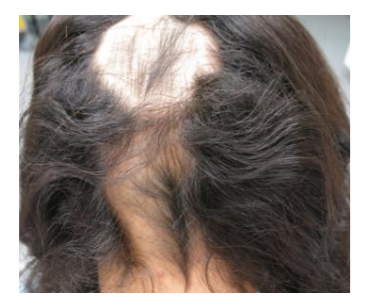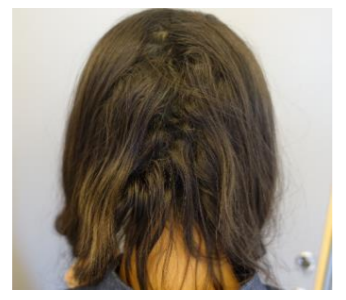Information
Journal Policies
Short - Time Psychodynamic Psychotherapy Intervention for
Longstanding Alopecia Areata
- A Case Report
Johan Fhager1*, Fatima Birch-Johansen1, Ake Svensson1, Karin Sjostrom1, Florence Dalgard1
Copyright :© 2018 Authors. This is an open-access article distributed under the terms of the Creative Commons Attribution License, which permits unrestricted use, distribution, and reproduction in any medium, provided the original author and source are credited.
We present the case of a woman in her late twenties who suffered fro m alopec ia areata for more than fifteen years. She was previously treated with topical medicine without effect. The patient considered her condition as untreatable and contacted the dermatology department in order to get a wig. At the first encounter with the dermatologist, signs of severe mental distress was presented and hence a referral to the specialized psycho-dermatology unit was made. The Hospital Anxiety and Depression Scale and the Dermatology Life Quality Index were used and showed clinical anxiety (HADS -A=12) and a large impact on quality of life (DLQI=13). She was offered treatment by short -time psychodynamic psychotherapy (STPP) addressing her unresolved feelings and conflicts. Rapid improvement was obtained with normalization of HADS and DLQI after four months. Unexpectedly, full regrowth of hair was observed after the eighth sessions of STPP and at the 12 months follow-up her hair-growth was fully replaced. Our findings suggest that STPP addressing unresolved conflicts could contribute to a recovery from AA. Further studies should examine this issue.
Alopecia areata, short-term psychotherapy, psychocutaneous disease, psycho -dermatology, psychosomatics,Psychiatry
Alopecia areata (AA) is an autoimmune inflammatory disease of the hair follicles, characterized with patchy non-scarring hair loss. Therapy includes topical and systemic dermatological therapies though no curative therapy has been established [1]. AA is recognized as a multi-etiological condition, and it is recognized that stress, alexithymia and anxiety have a significant impact on the disease course [2,3]. Psychological interventions such as short-term psychodynamic psychotherapy (STPP) with focus on affect, have shown to improve somatic disorders including skin diseases [4-6]. In our dermatology department dermatological patients with psychological comorbidity are referred to a specialized unit of psycho-dermatology. This multidisciplinary team includes a dermatologist, a psychiatrist and a social counselor trained in STPP. All patients referred to this unit are screened with the Hospital Anxiety and Depression Scale well known instrument for detection of anxiety and depression in hospital settings [7]. Patients are also screened with a dermatological quality of life scale the “Dermatology Life Quality Index” DLQI widely used clinically and academically in dermatology assessing the impairment of a skin condition in patients ‘lives [8]. In this paper we present a case with a patient with a 13 year history of AA, who regained full hair growth during our intervention with STPP at our specialized unit.
2. Case Report
A 29-year old woman with an earlier diagnosed AA was referred to the unit in January 2017. There was no heredity for hair diseases, though she had a history of atopic dermatitis during childhood. She was treated adequately for iron deficiency and hypothyreosis but treatment for these conditions had not resolved her hair condition. She had had several different topical hair treatments repeatedly without effect.
When she came to our dermatology department the patient considered her condition as untreatable and was motivated to wear a wig in order to cope psychosocially with her alopecia. The initial clinical examination showed non-scarring bald patches of the scalp with scarce hair central in the lesions (Figure 1). The patient has been seen in the clinic for over four years and was examined by several dermatologists who diagnosed her with AA.
In addition the patient revealed great mental distress however she appeared with a controlled behavior with difficulties to express her emotions [3,9]. The results from the Hospital Anxiety and Depression Scale confirmed clinical anxiety (HADS-A= 12) but no clinical depression (HADS-D= 6) [7]. The Dermatology Life Quality Index showed a very large impact on her life (DLQI= 13) [8]. Nevertheless her social situation appeared stable: she was living with her spouse and children and had a steady work nevertheless she described herself as genuinely unhappy. She reported that her colleagues would perceive her as orderly and tidy, and in the same way she felt largely responsible for the upbringing of her own children.
She accepted a STPP intervention by the social counselor primarily to address her distress. The aim of the psychodynamic intervention was to help the patient connect with her unprocessed emotions in order to make her see the impact on her present life [6,10]. The intervention consisted of eight weekly sessions of 50 minutes with a focus on her emotions and upbringing.
During therapy a difficult childhood was revealed, with both parents and sibling suffering from substance abuse. She had no history of substance abuse herself. She reported that her hair loss coincided with the time of the loss of her grand-mother with whom she had strong and positive bonds. The mourning process had been complicated due to family conflicts especially with her mother. In order to get through those difficult times she put her efforts to distance herself from her mother and sister because of their abuse. She felt now that her life still was unresolved.
During the sessions the patient processed painful experiences and conflicting feelings with family members particularly the mother. The later sessions were focused on her unprocessed feelings of anger, loss and mourning. She acknowledged how the intrusion of the mother caused her anger and despair. She related these circumstances to her need to develop an obsessional behavior to make rules, including controlling family life and household. At the final sessions she started to question her exaggerated sense of responsibility and the stress due to her controlling behavior. She was able to relate the controlling behavior to the unresolved emotions related to her past. She gained emotional relief and she started working again. She requested to end the therapy arguing that she had achieved gratifying results. After two months she was examined by the dermatologist and regrowth of her hair was observed and the screening measures were normalized. At one year follow-up in January 2018, her improved psychological condition was stable, HADS-A (score= 5) and HADS-D (score = 0) were normal, DLQI was 2 [7,8]. Her hair-growth continued so that she was no longer in need of a wig (figure 2).
3. Discussion
Our patient with a longstanding patchy hairloss presented with a substantial chronic mental distress and responded well to eight sessions of STPP with improvement of her mental problems. The association with a hair-growth in areas which had been without hair for thirteen years was an unexpected clinical outcome. The patient presented with an alexithymia showing difficulties in the identification of feelings and the description of them [3,7,10]. Unresolved unconscious emotional issues have long been suggested to be an important causal factor in a range of somatic disorders [10]. The total regrowth of scalp hair in our patient suggests that psychodynamic intervention with focus on affect may have a pivotal role in the treatment of alopecia. A meta-analysis by Abbas et al. suggests that STPP is effective as adjunctive or solo treatments for a range of somatic diseases including skin disease [6].
A limitation in this case study is that although the patient was diagnosed with alopecia areata the differential diagnosis of trichotillomania had been discussed. AA was considered most plausible because of the occipital localization and symmetry of the lesions nevertheless the diagnose of trichotillomania would effectively had been excluded with a biopsy. This was not possible as regrowth of hair was seen so rapidly and unexpectedly.
It is unknown what modulating factors influenced our patient. Extremely strong control behavior may be seen as an inadequate way to cope with inner stress and emotional chaos, which in turn may be the result of an inability of expressing high energy emotions [2,3,10].
Our patient exhibited high control behavior and difficulties to express emotions as anger and sorrow. This can lead to chronic mental stress which may, according to stress research, play a role in triggering skin inflammation by modulation of the hypothalamic-pituitary adrenal axis and thereby the immune systems [2,3,9].
Future research should include clinical studies investigating the efficacy of short term psychodynamic therapy in the treatment of AA.
Permissions
The patient has given consent to publish this article with photographs.
References
- Gupta AK., Carviel J., Abramovits W., Treating Alopecia Areata: Current Practices versus New Direct ions. J Dermatol. 2017 Nov; 44 (11):1199-1211. ; (Journal Article)
- Kuty-PacheckaM.Psychological and psychopathological factors in alopecia areata. Psychiatr Pol. 2015; 49 (5):955-64. (Journal Article)
- Willemsen R., Roseeuw D., Vanderlinden J., Alexithymia and dermatology: the state of the art. Int J Dermato l. 2008 Sep; 47 (9):903-10.; (Journal Article)
- Shah R., Bewley A., Psoriasis: 'the badge of shame'. A case report of a psychological intervention to reduce and potentially clear chronic skin disease. Clin Exp Dermatol. 2014 Jul;39(5):600-3. (Journal Article)
- Linnet J., Jemec GB., An xiety level and severity of skin condition predicts outcome of psychotherapy in atopic dermatit is patients. Int J Dermatol. 2001 Oct; 40 (10):632-6. ; (Journal Article)
- Abbass A., Kisely S., Kroenke K., Short-term psychodynamic psychotherapy for so matic disorders: Systematic review of meta-analysis of clinical trials. Psychotherapy and Psychosomatics, Vol 78(5), Ju l 11, 2009 pp. 265-274. Publisher: Karger; (Journal Article)
- Zig mond, A. S., Snaith, R. P., (1983). The Hospital An xiety and Depression Scale. Acta Psychiatrica Scandinavica, 67, 361-370. (Journal Article)
- Fin lay A Y., Khan GK., "Dermatology Life Quality Index (DLQI) - a simple practical measure for routine clin ical use". Clinical and Experimental Dermatology, 1994; 19: 210-216. (Journal Article)
- Colaianni G., Poot F., How to Reach Emotions with Psychosomatic Patients: A Case Report. Acta Derm Venereol. 2016 Aug 23; 96 (217):109-12. (Case report)
- Alexander F., Analysis of the therapeutic factors in psychoanalytic treat ment. 1950. Psychoanal Q. 2007 Oct; 76 (4):1065-83. (Journal Article).






